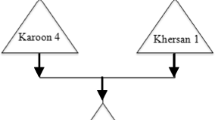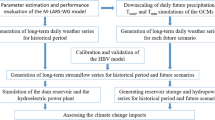Abstract
The management adaptation potential of the Peribonka River water resource system (Quebec, Canada) is investigated in the context of the evolution of climate change. The objective of this study is to evaluate the impacts on hydropower, power plant efficiency, unproductive spills and reservoir reliability due to changes in the hydrological regimes. The climate change projections used here are from the Canadian regional climate model (CRCM) nested by the Canadian-coupled global climate model (CGCM3) forced with the SRES A2 greenhouse gas emission scenario. The hydrological regimes were simulated with the distributed hydrological model Hydrotel. They were incorporated into a dynamic and stochastic optimization model in order to adapt the operating rules of the water resource system annually, according to the evolution of the climate. The impacts were analyzed over the years 1961–2099, split into four periods for comparison purposes: control period (1961–1990), horizon 2020 (2010–2039), horizon 2050 (2040–2069) and horizon 2080 (2070–2099). The main results indicate that annual mean hydropower would decrease by 1.8% for the period 2010–2039 and then increase by 9.3% and 18.3% during the periods 2040–2069 and 2070–2099, respectively. The trend to increase is statistically significant starting from 2061 (Mann–Kendall with p = 5%). The change in the mean annual production is statistically significant for the 2040–2069 and 2070–2099 periods (t-test with p = 5%). Also, the change in the variance is significant for the periods 2010–2039, 2040–2069 and 2070–2099 (F-test). Annual mean unproductive spills would increase from 1961–2099, but the trend is not statistically significant. However, the changes in the variance of the annual mean spills are significant in the periods 2010–2039, 2040–2069 and 2070–2099. Overall, the reliability of a reservoir would decrease and the vulnerability increase as the climate changes.
Similar content being viewed by others
References
Caya D, Laprise R (1999) Semi-implicit semi-Lagrangian regional climate model: the Canadian RCM. Mon Weather Rev 127(3):341–362
Christensen NS, Wood AW, Voisin N, Lettenmaier DP, Palmer RN (2004) The effects of climate change on the hydrology and water resources of the Colorado river basin. Clim Change 62:337–363
Fortin J-P, Turcotte R, Massicotte S, Moussa R, Fitzback J, Villeneuve J-P (2001) Distributed watershed model compatible with remote sensing and GIS data. 1: description of the model. J Hydrol Eng 6(2):91–99
Fowler HJ, Kilsby CG (2007) Using regional climate model data to simulate historical and future river flows in northwest England. Clim Change 80:337–367
Fowler HJ, Blenkinsop S, Tebaldi C (2007) Linking climate change modelling to impacts studies: recent advances in downscaling techniques for hydrological modelling. Int J Climatol 27:1547–1578
Hamed KH (2008) Trend detection in hydrologic data: the Mann–Kendall trend test under the scaling hypothesis. J Hydrol 349:350–363
Hayhoe K, Wake CP, Huntington TG, Luo L, Shchwartz MD, Sheffield J, Wood E, Anderson B, Bradbury J, DeGaetano A, Troy TJ, Wolfe D (2007) Past and future changes in climate and hydrological indicators in the US Northeast. Clim Dyn 28(4):381–407
IPCC (2007) Climate change 2007: Impacts, adaptation and vulnerability. Contribution of working group II to the fourth assessment report of the intergovernmental panel of climate change. In: Parry ML, Canziani JP, Palutikof JP, van der Linden PJ, Hanson CE (eds) Intergovernmental panel on climate change. Cambridge, UK, 1000 p
Kalra A, Piechota TC, Davies R, Tootle GA (2007) Changes in U.S. streamflow and western U.S. snowpack. J Hydrol Eng 13(3):156–163
Kendall MG (1975) Rank correlation methods. Griffin, London
Kundzewicz ZW, Mata LJ, Arnell NW, Döll P, Kabat P, Jiménez B, Miler KA, Oki T, Sen Z, Shiklomanov IA (2007) Freshwater resources and their management. In: Canziani OF, Parry ML, Palutikof JP, van der Linden PJ, Hanson CE (eds) Climate change 2007: impacts, adaptation and vunerability. Contribution of working group II to the fourth assessment report of the intergovernmental panel on climate change. Cambridge University Press, Cambridge, UK, pp 173–210
Labadie JW (2004) Optimal operation of multireservoir systems: state-of-the-art review. J Water Resour Plan Manage 130(2):93–111
Mann HB (1945) Nonparametric tests against trend. Econometrica 13:245–259
Markoff MS, Cullen AC (2008) Impact of climate change on Pacific Northwest hydropower. Clim Change 87:451–469
Maurer EP (2007) Uncertainty in hydrologic impacts of climate change in the Sierra Nevada, California, under two emissions scenarios. Clim Change 82:309–325
McFarlane NA, Boer GG, Blanchet J-P, Lazare M (1992) The Canadian climate centre second-generation general circulation model and its equilibrum climate. J Climate 5:1013–1044
Minville M, Brissette F, Leconte R (2008) Uncertainty of the impact of climate change on the hydrology of a Nordic Watershed. J Hydrol 358(1–2):70–83
Nakicenovic N, Alcamo J, Davis G, de Vries B, Fenhann J, Gaffin S, Gregory K, Grübler A, Jung TY, Kram T, La Rovere EL, Michaelis L, Mori S, Morita T, Pepper W, Pitcher H, Price L, Raihi K, Roehrl A, Rogner H-H, Sankovski A, Schlesinger M, Shukla P, Smith S, Swart R, van Rooijen S, Victor N, Dadi Z (2000) IPCC special report on emissions scenarios. United Kingdom and New York, NY, USA, p 599
Nash JE, Sutcliff JV (1970) River flow forecasting through conceptual models. 1. A discussion of principles. J Hydrol 10(3):282–290
Olesen JE, Carter TR, Diaz-Ambrona CH, Fronzek S, Heidmann T, Hickler T, Holt T, Minguez MI, Ruiz-Ramos M, Rubaek GH, Sau F, Smith B, Sykes MT (2007) Uncertainties in projected impacts of climate change on European agriculture and terrestrial ecosystems based on scenarios from regional climate models. Clim Change 81:123–143
Payne JT, Wood AW, Hamlet AF, Palmer RN, Lettenmaier DP (2004) Mitigating the effects of climate change on the water resources of the Columbia river basin. Clim Change 62:233–256
Plummer DA, Caya D, Frigon A, Cote H, Giguere M, Paquin D, Biner S, Harvey R, De elia R (2006) Climate and climate change over North America as simulated by the Canadian RCM. J Climate 19(13):3112–3132
Regonda SK, Rajagopalan B, Clark M, Pitlick J (2005) Seasonal cycle shifts in hydroclimatology over the western United States. J Climate 18(2):372–384
Salathé EP Jr, Mote PW, Wiley MW (2007) Review of scenario selection and downscaling methods for the assessment of climate change impacts on hydrology in the United States pacific northwest. Int J Climatol 27:1611–1621
Schmidli J, Frei C, Vidale PL (2006) Downscaling from GCM precipitation: a benchmark for dynamical and statistical downscaling methods. Int J Climatol 26:679–689
Semenov MA, Brooks RJ, Barrow EM, Richardson CW (1998) Comparison of the WGEN and LARS-WG stochastic weather generators for diverse climates. Clim Res 10:95–107
Simonovic SP, Li L (2004) Sensitivity of the Red river basin flood protection system to climate variability and change. Water Resour Manag 18:89–110
Turcotte R, Fortin L-G, Fortin V, Villeneuve J-P (2007) Operational analysis of the spatial distribution and the temporal evolution of the snowpack water equivalent in southern Quebec, Canada. Nord Hydrol 38(3):211–234
Turgeon A (2005) Solving a stochastic reservoir management problem with multilag autocorrelated inflows. Water Resour Res 41:W12414
VanRheenen NT, Wood AW, Palmer RN, Lettenmaier DP (2004) Potential implications of PCM climate change scenarios for Sacremento-San Joaquin river basin hydrology and water resources. Clim Change 62:257–281
Whitfield PH, Cannon AJ (2000) Recent variation in climate and hydrology in Canada. Can Water Resour J 25(1):19–65
Wood AW, Leung LR, Sridhar V, Lettenmaier DP (2004) Hydrologic implications of dynamical and statistical approaches to downscaling climate model outputs. Clim Change 62:189–216
Author information
Authors and Affiliations
Corresponding author
Rights and permissions
About this article
Cite this article
Minville, M., Brissette, F., Krau, S. et al. Adaptation to Climate Change in the Management of a Canadian Water-Resources System Exploited for Hydropower. Water Resour Manage 23, 2965–2986 (2009). https://doi.org/10.1007/s11269-009-9418-1
Received:
Accepted:
Published:
Issue Date:
DOI: https://doi.org/10.1007/s11269-009-9418-1




